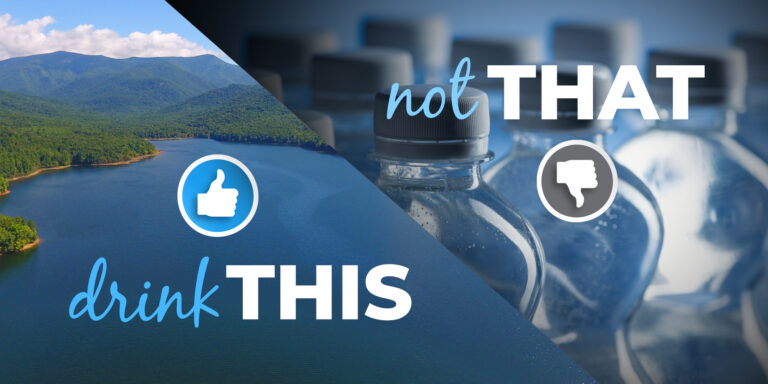In recent years, many cities have been in the news when water from their distribution systems did not meet national safe drinking water standards. It’s easy to understand why more and more residents are feeling concerned about their water. Some are choosing bottled water over tap, because they think it’s a safer alternative. However, take note of this: Bottled water is not held to the same regulatory standards as tap water and it is not safe to assume that bottled water is always a healthier choice than tap water.
In Asheville specifically, our municipal water supply originates from pure mountain streams and springs on protected land. The quality of our natural water source almost meets Environmental Protection Agency (EPA) standards in its natural state. Drinking Asheville’s tap water can provide better health outcomes and lessen environmental impacts.
Testing Standards
Municipal tap water is regulated by the Environmental Protection Agency (EPA), while bottled water is regulated by the Food and Drug Administration (FDA). Both tap and bottled water are tested for contaminants, but there are differences in the testing parameters.
In accordance with state and federal laws, municipal water systems are required to continuously monitor tap water, notify the public of any health hazards, and publish an annual report (Consumer Confidence Report) with details of the water source, contaminants tested and maximum contaminant levels.
The Safe Drinking Water Act (SDWA), which is enforced by the EPA, requires public water systems to routinely test the water at certified laboratories and report any violations within a certain time frame.
The FDA does not require certified lab testing, daily or routine testing, violation reporting, information about the source, or any details regarding how the bottled water was treated. Marketers may indicate on the label the source of water and how it was treated, but it is optional – not required. FDA regulations do not cover water that is packaged and sold within the same state, resulting in 60 to 70 percent of bottled water, including water-cooler water, being fairly unregulated.
In general, the FDA has adopted the EPA’s maximum contaminant levels for drinking water though there are several instances where standard regulations differ, mostly due to differences in the method of distribution. Bottled water comes from a source that may or may not be treated and is packaged and distributed in stores.
In short, the testing standards of the EPA are more stringent than those of the FDA and are more likely to provide a safer product.
Health Impacts
While on the shelves in stores, bottled water can grow unhealthy bacteria. Some types of bacteria can be particularly harmful for people with weakened immune systems.
Tap water is required by state and federal laws to contain a residual level of chlorine (or other approved disinfectant) throughout the distribution system in order to prevent the growth of such bacteria. Most of the chlorine can be removed by using an activated carbon filter on a faucet or in a specific type of pitcher.
Water in plastic bottles is also susceptible to absorbing phthalates and bisphenol A, also known as BPA, which can be detrimental to health, especially in infants and children, according to the National Institute of Environmental Health Sciences.
Environmental Impacts
Plastic bottles are made from fossil fuels. Although they are recyclable, most bottles are thrown into landfills rather than recycled. By the gallon, bottled water is 600 times more expensive than tap, according to the International Bottled Water Association (IBWA) and the EPA.
Bottled water can come from springs and other sources, but often it is just tap water that has gone through a carbon filter. It would be economically and environmentally more sustainable to attach a carbon filter to a faucet or use a pitcher with a filter for the same effect.
Microplastics and residual chemicals from single-use plastics pose serious threats to human health. Using non-plastic reusable water bottles reduces these risks for you and your family.
In addition to safety, long-term sustainability is a factor. In the Asheville area, we are fortunate to have access to an abundant, pristine water source. That is not the case everywhere. Clean, reliable water is becoming increasingly scarce, and must be protected for the long term.
If people continue to consume bottled water at current rates, it will lead to increased stress on landfill capacities, energy use, air pollution and other environmental challenges. Over 14% of landfilled waste in Buncombe County is plastic. To support waste reduction, the City of Asheville has adopted a waste reduction goal of 50% by 2035. Opting for tap water over bottled significantly advances this goal. Considering the future of our community and our sustainability goals, the environmental impact of bottled water is of critical importance.
Asheville’s Water Source
 Now let’s consider the source of Asheville’s drinking water.
Now let’s consider the source of Asheville’s drinking water.
The City of Asheville owns over 20,000 acres of forested mountains surrounding our primary watersheds in eastern Buncombe County, making it one of the largest municipally owned watersheds in the United States. The land is protected by conservation easements which restrict development and pollution.
The North Fork and Bee Tree water treatment plants are fed by reservoirs where water flows from pure mountain springs and streams. As the water comes into the treatment plants, it is very close to meeting EPA standards in its natural state. This is exceedingly rare. Asheville is fortunate to have these natural resources and it’s very easy to see why our drinking water is considered some of the finest available anywhere.
The best choice is…
In Asheville, our tap water is safer, cheaper, cleaner, more environmentally sustainable and it tastes better than bottled water. The choice is easy!
Many thanks to Tanya Rose, Chris Clarke and Dan Phairas for their contributions to this article.
